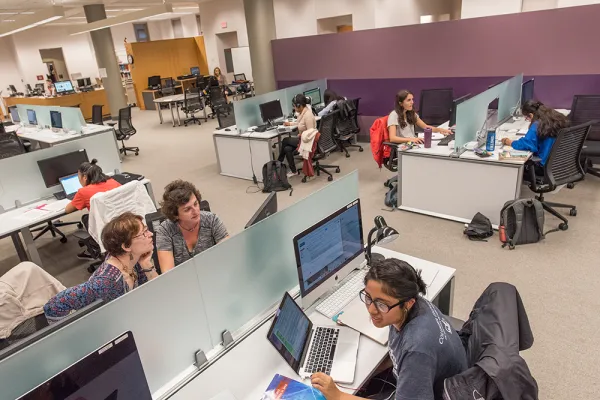SmithScape: New App Helps Users Find Study Spaces on Campus

Published July 31, 2017
Looking for a different place to study on campus? Maybe one with lots of natural light and just a “low hum” of noise? Now, there’s an app for that!
SmithScape—a program developed in part by Smithies and being tested this summer by Smith School for Social Work students—offers information on upwards of 80 study spaces on campus, including some new ones created as part of the renovation of Neilson Library.
Accessible from a smart phone or laptop, SmithScape allows users to search for study areas by space type, resources offered, lighting—even noise levels. (Filters for the latter include “silent,” “low hum” and “chatter.”)
The app—designed by Smith Libraries in partnership with Common Media, a Hadley-based digital service agency, using an open-source application developed by the University of Washington—aims to be a tool for students during the library renovation, when many familiar study areas will be unavailable.
More than two dozen Smith students helped design SmithScape—a level of engagement Provost Katherine Rowe cites as an important part of planning for a new Neilson.
“From the beginning, the planning has been driven by what students told us they need and how they work,” Rowe says. “So it’s very exciting to see the same student expertise helping to design how we create a library experience all over campus during the renovation of Neilson.”
Danyi Zeng ’17, one of the students who helped develop SmithScape, says the app “offers a completely new way for students to explore and interact with our campus. It makes a lot of information more transparent and helps students find the study spaces that suit them most.”
Zeng began working on SmithScape in associate professor Caroline Melly’s spring anthropology colloquium. In a project coordinated by Melly and associate professor Suzanne Gottschang, students used archival research and focus groups to help develop the app and identify the most desirable study spaces on campus.
“This project gave anthropology majors an insight into the discipline’s many practical applications and helped them develop skills that will be useful in their future careers,” Melly says.
Zeng, who hopes to pursue a graduate degree in science and technology studies, says students played a key role in creating a new campus learning tool.
“Our research revealed many diversities [in study practices] among the Smith student body—between first-years and seniors, humanities majors and STEM majors, and so on,” she says.
In addition to Zeng, Yoon Roh ’17 and Geena Choo ’17 also played leadership roles in the project.
Brendan O’Connell, an instructional technology librarian at Smith who is project manager for SmithScape, says student research shaped the app’s design.
“We made a number of changes based on student feedback,” he says. “Students even came up with the name.”
Feedback from SSW students will help refine SmithScape, O’Connell says, and increase the number of study spaces it describes to upwards of 100 by the start of fall semester, when the app will be available to the entire campus community.
What’s the most important thing to know about SmithScape?
“It’s fun—so you should try it!” Zeng says.